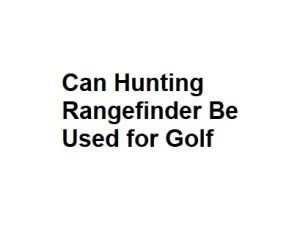Golfers are always looking for ways to improve their game, and one tool that has gained popularity in recent years is the rangefinder. Rangefinders are commonly used in hunting to measure the distance between the hunter and their target, but can these hunting rangefinders be used for golf as well? In this article, we will explore whether hunting rangefinders can serve a dual purpose on the golf course.
Understanding Rangefinders:
Before we delve into their applicability in golf, it’s important to understand how rangefinders work. Rangefinders use laser technology to measure the distance between the user and a target object. This technology calculates the time it takes for the laser beam to bounce off the target and return to the device, providing an accurate distance reading.
Hunting Rangefinders vs. Golf Rangefinders:
While hunting rangefinders and golf rangefinders share a common technology, they are designed with different purposes in mind. Here are the key differences:
- Range and Accuracy: Hunting rangefinders are typically designed for longer distances and may have a broader range. They are optimized for measuring distances to large objects like trees or animals. In contrast, golf rangefinders are tailored for shorter distances, providing precise measurements to the flagstick or hazards on the golf course.
- Target Priority: Hunting rangefinders often feature a “first target priority mode” that focuses on the nearest object, which may not always be the flagstick on a golf course. Golf rangefinders, on the other hand, use “pin-seeking” technology to lock onto the flagstick, ignoring background objects.
- Ease of Use: Golf rangefinders are designed for ease of use on the golf course. They often come with features like slope compensation and pre-loaded course maps. Hunting rangefinders may lack these golf-specific features.
Using a Hunting Rangefinder for Golf:
While hunting rangefinders are not specifically designed for golf, they can still be used on the course. Here are some considerations:
- Distance Measurements: A hunting rangefinder can provide accurate distance measurements on the golf course. However, golfers should be aware that it may not lock onto the flagstick as consistently as a dedicated golf rangefinder.
- Target Selection: Golfers using hunting rangefinders should be cautious when selecting targets, as these devices may prioritize larger objects in the background. It’s important to aim carefully to get an accurate reading.
- Slope Adjustment: Many hunting rangefinders do not have slope compensation features, which are helpful for calculating the adjusted distance based on elevation changes. Golf rangefinders often include this feature.
Alternative Options for Golfers:
- Golf GPS Devices: In addition to rangefinders, many golfers use GPS devices or smartphone apps designed explicitly for golf. These devices offer detailed course maps, accurate yardages, and features like shot tracking and scorekeeping. Golf GPS devices provide a comprehensive golfing experience and are often preferred by players who want more than just distance measurements.
- Hybrid Rangefinders: Some rangefinders are designed to bridge the gap between hunting and golf applications. Hybrid rangefinders offer both laser and GPS functionality, allowing golfers to get accurate distance readings while also benefiting from GPS course information.
- Laser Golf Rangefinders: If you are serious about golf and want the most accurate and reliable distance measurements, it’s advisable to invest in a dedicated laser golf rangefinder. These devices are specifically engineered to prioritize flagsticks and deliver precise yardages, making them the preferred choice for many golfers.
Types of Rangefinders
| Type | Range (Yards) | Magnification | Slope Compensation | Suitable for Golf |
|---|---|---|---|---|
| Golf Rangefinder | 300-1000+ | 5x-7x | Yes | Yes |
| Hunting Rangefinder | 500-1200+ | 6x-10x | No | Yes |
| Laser Rangefinder | Variable | Variable | Variable | Variable |
Key Features for Golf Use
| Feature | Description |
|---|---|
| PinSeeker Technology | Locks onto the flagstick, ignoring background |
| Slope Mode | Calculates slope-adjusted distances |
| Jolt Technology | Vibrates when locked onto the target |
| Water Resistance | Protects against rain or wet conditions |
| Slope Switch | Easily toggle slope compensation |
Popular Golf Rangefinder Models
| Model | Maximum Range (Yards) | Magnification | Slope Compensation | Price Range ($) |
|---|---|---|---|---|
| Bushnell Pro X2 | 1300 | 6x | Yes | 400-500 |
| Nikon Coolshot 20 | 550 | 6x | No | 150-200 |
| Garmin Approach Z80 | 350 | 6x | Yes | 500-600 |
Popular Hunting Rangefinder Models
| Model | Maximum Range (Yards) | Magnification | Slope Compensation | Price Range ($) |
|---|---|---|---|---|
| Vortex Optics Ranger 1800 | 1800 | 6x | No | 300-400 |
| Leupold RX-1300i TBR | 1300 | 6x | Yes | 300-400 |
| Nikon Monarch 3000 | 3000 | 8x | No | 400-500 |
Pros and Cons of Using a Hunting Rangefinder for Golf
| Aspect | Pros | Cons |
|---|---|---|
| Price | Often more affordable than dedicated golf rangefinders | Lacks some golf-specific features |
| Range | Longer range capabilities | May not have PinSeeker technology |
| Magnification | Typically offers higher magnification | May not have slope compensation |
| Versatility | Can be used for both golf and hunting | May be bulkier and less ergonomic |
| Legal Considerations | May be allowed in tournaments | Check local rules and regulations |
Final Thoughts:
In summary, while hunting rangefinders can be used for golf in a pinch, golfers looking for the best experience and accuracy on the course should opt for dedicated golf rangefinders or GPS devices. These golf-specific tools are designed with features and capabilities tailored to the unique demands of the game, ultimately helping golfers make more informed decisions and improve their performance on the links.



